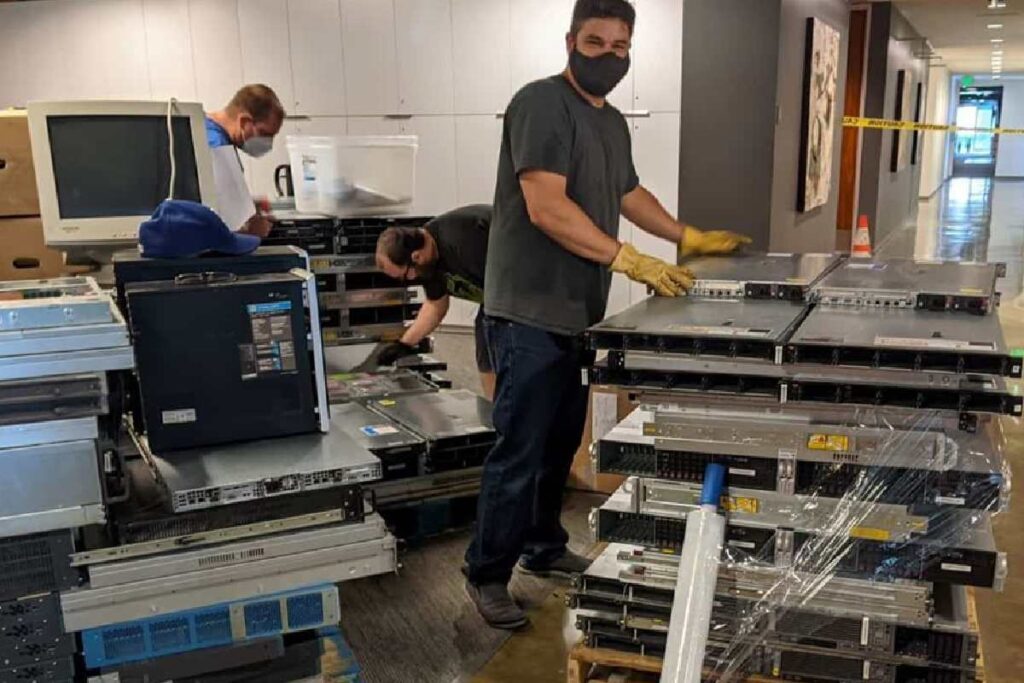Considering that the implementation of new technologies accelerates and advances with time, data centres are more often updating their facilities to meet modern requirements. Such change invariably leads to obsolescence or redundancy of equipment that once served useful purposes in the business environment. The exercise of retiring a data centre as a business entity is known as data centre decommissioning and entails the process of IT Asset Disposition (ITAD). In this blog post explaining ITAD in the context of data centre decommissioning, the author discusses its relevance, stages, best practices, and compliance in terms of data and environmental protection.
An Overview of IT Asset Disposition or ITAD
Importance and Definition ITAD stands for IT Asset Disposition (ITAD) Process and it deals with the management of disposal of IT assets which are no longer needed by the owner through proper management techniques that are environmentally safe. They may include servers, storage, switching and routing equipment among other hardware resources employed in data centres. The ITAD process is critical for several reasons:The ITAD process is critical for several reasons:
- Data Security: Eradicating or deleting the data from the storage media in such a way that it is not retrievable to unauthorised personnel.
- Environmental Responsibility: Minimising the amount of hazardous electronic waste that poses a threat to the environment.
- Regulatory Compliance: Meeting legal and industry requirements concerning data security and management of wastes.
- Cost Efficiency: Deriving value from assets that are no longer useful or needed through resale or recycling activities.
The Usage of ITAD in the Decommissioning Process of Data Center
ITAD becomes very essential when a data centre needs to be decommissioned since it handles details of the lifecycle of IT assets. This includes the process to ascertain assets for disposal, sanitising data, redeploying/reuse or reselling IT assets and documenting the process to ensure compliance. ITAD when it comes to data centre decommissioning is very extensive since it entails several activities to achieve the ultimate goal of disposal of data centre products.
The ITAD Process: Step-by-Step
Planning and Assessment
The first stage of this process is a proper planning and evaluation of all the overall proposals. This involves:
- Inventory Management: Making a comprehensive list of all the IT assets still in the data centre and their make, model, and condition.
- Risk Assessment: Risk assessment of the data breaches which threatens the organisation, failure to meet regulatory requirements, and impact on the environment.
- Resource Allocation: Division of tasks and control of the necessary funds and equipment in relation to each stage of the work on decommissioning.
Data sanitization
Data sanitization is perhaps the most crucial process in ITAD, especially when it comes to data center deinstallation. It involves:
- Data Wiping: Overwriting the existing data using the software tools several times to a point where the data cannot be recovered again.
- Degaussing: Destroying data through exposure of magnetic storage devices to an intense magnetic field.
- Physical Destruction: erasing information by impacting the storage devices such as by shredding or crushing it so that information cannot be retrieved.
Asset Valuation and Resale
After data sanitization, the next process depends on the determination of the residual value of the IT assets. This involves:
- Market Analysis: Evaluating the modern market and determining the demand for reusable IT property.
- Refurbishment: Bowling equipment modification for improving its general usability and attractiveness to third party buyers.
- Resale or Donation: recycling of these equipments by selling them through outlets such as second hand markets or donating them to worthy causes.
Recycling and Disposal
In case of non-usable and non-salvageable assets, recycling and disposal play a vital role. This includes:
- Material Recovery: Recycling involves the recovery of valuable materials from wastes such as metals, plastics, and components.
- Environmental Compliance: Compliance with environmental laws on the disposal of hazardous items.
- Documentation: documenting the process of recycling for auditors or compliance with the laws of the land.
Documentation and Reporting
Documentation is also crucial during the entire procedure of the ITAD to avoid any doubt. This involves:
- Audit Trails: Keeping records on the shelf-life of each asset to its decommissioning, disposal, and subsequent disposal.
- Compliance Reports: Creating reports that will show compliance in Data Protection and the Environmental laws.
- Certificates of Destruction: Flying a flag that would show people that data has been erased or deleted in a secure manner.
Best Practices for ITAD in Data Center Decommissioning
IT assets should be managed through an effective IT Asset Disposition policy that encompasses all the mentioned strategies.
A detailed policy document containing the procedure, roles and responsibilities, and compliance standards should be developed for proper ITAD. This policy should be reviewed and adjusted, for example, within six months or annually depending on changes in technology, regulations, and organisational goals.
Engage certified ITAD vendors.
Working with certified ITAD contractors assures that the disposal process is done by experts in data disposal and environmental conservation. Ensure that they have the R2 (Responsible Recycling) and e-Stewards certifications to show commitment to proper management of the IT assets.
It is also important that there is a safe custody of the evidence.
Ensuring there is a chain of custody of IT assets from the data centre to the disposal site is very important. This consists in controlling the movement of every asset, how they are transported and the possibility of access by anyone other than the authorised personnel.
Continuously monitor and audit the compliance programs to make sure they are up to date and effective.
Periodic evaluation and assessment of the ITAD process aid in early detection of risks and ascertaining whether the process is in compliance with the standards. The following are some ways through which continuous improvement approaches can also be adopted using the audit results for improving the efficiency and security of the ITAD process as follows:
Educate and train staff.
It is thus effective to make sure all the concerned staff for the ITAD process have adequate knowledge regarding data security, compliance, and environmental care. It has their best interest and new training that needs to be done in order to update the team on the new developments, current standards, and regulations.
Compliance and Regulatory Considerations
Data protection regulations
Policies on data protection acts are another important factor in the process of implementing ITAD. The European Data Protection law known as GDPR and the American one called CCPA are just two examples of the rules that can dictate specific conditions for data disposal. Other regulation requirements include guaranteeing that data is erased or disposed of in a secure manner during Data Center Decommissioning to prevent any legal implication.
Environmental Regulations
E-scrap is regulated by Environmental laws as environmental friendly methods have to be followed while dealing with leads, mercury and cadmium etc. . Measures such as the WEEE Directive in Europe and the Resource Conservation and Recovery Act (RCRA) in the United States have to be followed to reduce the effects on the environment as much as possible.
Industry Standards and Certifications
The purpose of maintaining standards and going for certification is not only about strengthening the organisation’s image but also following the industry norms. Industry standard accreditations like the ISO 14001 for environmental management and ISO 27001 for information security management are helpful when trying to prove a company’s seriousness in managing IT assets disposal responsibly.
Many aspects of technology have a role in ITAD
Automation and asset tracking
Here, it is crucial to note that today, assorted ITAD operations could be easily motorized and automated. This can be particularly beneficial when tracking the status of IT assets, so that no equipment are missed during the decommission process.

Blockchain for secure documentation
ITAD is one of the spheres where blockchain technology is gaining popularity as a tool that increases the level of security and transparency of the corresponding processes. As a result, the use of blockchain to create a decentralised ledger of all actions made during the Data Center Decommissioning process makes the documentation of compliance as well as the asset disposition consistent and almost impossible to be altered.
AI and Machine Learning for Asset Valuation
There is a need to employ artificial intelligence and machine learning for the purpose of ascertaining more value of the IT assets. AI can also determine how to get the most from redundant assets through analysing trends in market, usage, and the condition of the equipment. Hunterposts.com
Conclusion
The IT Asset Disposition (ITAD) process is a crucial process that must be followed when retiring a data centre to ensure that no longer required IT assets are recycled or disposed of legally and sustainably. When becoming a customer-oriented and legally compliant organisation, it is possible to follow the developed structure of ITAD process, use best practices, and apply the up-to-date technologies to minimise the threats and increase the opportunities to achieve the maximal level of value recovery. Indeed, as mentioned above, with the ongoing changes in data centres, ITAD will become even more crucial for managing company assets effectively, and any company that wants to be ahead of competitors should already have a proper strategy in place.

